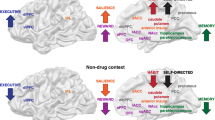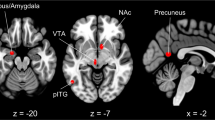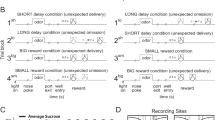Abstract
Cocaine addiction is characterized by poor judgment and maladaptive decision-making. Here we review evidence implicating the orbitofrontal cortex in such behavior. This evidence suggests that cocaine-induced changes in orbitofrontal cortex disrupt the representation of states and transition functions that form the basis of flexible and adaptive 'model-based' behavioral control. By impairing this function, cocaine exposure leads to an overemphasis on less flexible, maladaptive 'model-free' control systems. We propose that such an effect accounts for the complex pattern of maladaptive behaviors associated with cocaine addiction.
This is a preview of subscription content, access via your institution
Access options
Subscribe to this journal
Receive 12 print issues and online access
$209.00 per year
only $17.42 per issue
Buy this article
- Purchase on Springer Link
- Instant access to full article PDF
Prices may be subject to local taxes which are calculated during checkout




Similar content being viewed by others
References
Mendelson, J.H. & Mello, N.K. Management of cocaine abuse and dependence. N. Engl. J. Med. 334, 965–972 (1996).
Cardinal, R.N., Parkinson, J.A., Hall, G. & Everitt, B.J. Emotion and motivation: the role of the amygdala, ventral striatum, and prefrontal cortex. Neurosci. Biobehav. Rev. 26, 321–352 (2002).
Daw, N.D., Niv, Y. & Dayan, P. Uncertainty-based competition between prefrontal and dorsolateral striatal systems for behavioral control. Nat. Neurosci. 8, 1704–1711 (2005).
Daw, N.D., Gershman, S.J., Seymour, B., Dayan, P. & Dolan, R.J. Model-based influences on humans' choices and striatal prediction errors. Neuron 69, 1204–1215 (2011).
Thorpe, S.J., Rolls, E.T. & Maddison, S. The orbitofrontal cortex: neuronal activity in the behaving monkey. Exp. Brain Res. 49, 93–115 (1983).
O'Doherty, J., Rolls, E.T., Francis, S., Bowtell, R. & McGlone, F. Representation of pleasant and aversive taste in the human brain. J. Neurophysiol. 85, 1315–1321 (2001).
Liu, X. et al. Functional dissociation in frontal and striatal areas for processing of positive and negative reward information. J. Neurosci. 27, 4587–4597 (2007).
Rolls, E.T. & Baylis, L.L. Gustatory, olfactory, and visual convergence within the primate orbitofrontal cortex. J. Neurosci. 14, 5437–5452 (1994).
Sul, J.H., Kim, H., Huh, N., Lee, D. & Jung, M.W. Distinct roles of rodent orbitofrontal and medial prefrontal cortex in decision making. Neuron 66, 449–460 (2010).
Wallis, J.D. & Miller, E.K. Neuronal activity in primate dorsolateral and orbital prefrontal cortex during performance of a reward preference task. Eur. J. Neurosci. 18, 2069–2081 (2003).
Roesch, M.R. & Olson, C.R. Neuronal activity in primate orbitofrontal cortex reflects the value of time. J. Neurophysiol. 94, 2457–2471 (2005).
O'Doherty, J., Kringelbach, M.L., Rolls, E.T., Hornak, J. & Andrews, C. Abstract reward and punishment representations in the human orbitofrontal cortex. Nat. Neurosci. 4, 95–102 (2001).
Breiter, H.C., Aharon, I., Kahneman, D., Dale, A. & Shizgal, P. Functional imaging of neural responses to expectancy and experience of monetary gains and losses. Neuron 30, 619–639 (2001).
Schoenbaum, G., Chiba, A.A. & Gallagher, M. Orbitofrontal cortex and basolateral amygdala encode expected outcomes during learning. Nat. Neurosci. 1, 155–159 (1998).
Tremblay, L. & Schultz, W. Relative reward preference in primate orbitofrontal cortex. Nature 398, 704–708 (1999).
Padoa-Schioppa, C. & Assad, J.A. Neurons in the orbitofrontal cortex encode economic value. Nature 441, 223–226 (2006).
Hikosaka, K. & Watanabe, M. Long- and short-range reward expectancy in the primate orbitofrontal cortex. Eur. J. Neurosci. 19, 1046–1054 (2004).
Critchley, H.D. & Rolls, E.T. Hunger and satiety modify the responses of olfactory and visual neurons in the primate orbitofrontal cortex. J. Neurophysiol. 75, 1673–1686 (1996).
O'Doherty, J. et al. Sensory-specific satiety-related olfactory activation of the human orbitofrontal cortex. Neuroreport 11, 399–403 (2000).
Gottfried, J.A., O'Doherty, J. & Dolan, R.J. Encoding predictive reward value in human amygdala and orbitofrontal cortex. Science 301, 1104–1107 (2003).
Gallagher, M., McMahan, R.W. & Schoenbaum, G. Orbitofrontal cortex and representation of incentive value in associative learning. J. Neurosci. 19, 6610–6614 (1999).
Izquierdo, A., Suda, R.K. & Murray, E.A. Bilateral orbital prefrontal cortex lesions in rhesus monkeys disrupt choices guided by both reward value and reward contingency. J. Neurosci. 24, 7540–7548 (2004).
Pickens, C.L. et al. Different roles for orbitofrontal cortex and basolateral amygdala in a reinforcer devaluation task. J. Neurosci. 23, 11078–11084 (2003).
Ostlund, S.B. & Balleine, B.W. Orbitofrontal cortex mediates outcome encoding in Pavlovian but not instrumental conditioning. J. Neurosci. 27, 4819–4825 (2007).
Burke, K.A., Franz, T.M., Miller, D.N. & Schoenbaum, G. Conditioned reinforcement can be mediated by either outcome-specific or general affective representations. Front. Integr. Neurosci 1, 2 (2007).
Pears, A., Parkinson, J.A., Hopewell, L., Everitt, B.J. & Roberts, A.C. Lesions of the orbitofrontal but not medial prefrontal cortex disrupt conditioned reinforcement in primates. J. Neurosci. 23, 11189–11201 (2003).
Cousens, G.A. & Otto, T. Neural substrates of olfactory discrimination learning with auditory secondary reinforcement. I. Contributions of the basolateral amygdaloid complex and orbitofrontal cortex. Integr. Physiol. Behav. Sci. 38, 272–294 (2003).
Mobini, S. et al. Effects of lesions of the orbitofrontal cortex on sensitivity to delayed and probabilistic reinforcement. Psychopharmacology (Berl.) 160, 290–298 (2002).
Winstanley, C.A., Theobald, D.E.H., Cardinal, R.N. & Robbins, T.W. Contrasting roles of basolateral amygdala and orbitofrontal cortex in impulsive choice. J. Neurosci. 24, 4718–4722 (2004).
Camille, N. et al. The involvement of the orbitofrontal cortex in the experience of regret. Science 304, 1167–1170 (2004).
Schoenbaum, G., Roesch, M.R., Stalnaker, T.A. & Takahashi, Y.K. A new perspective on the role of the orbitofrontal cortex in adaptive behaviour. Nat. Rev. Neurosci. 10, 885–892 (2009).
Kremer, E.F. Rescorla-Wagner model – losses in associative strength in compound conditioned stimuli. J. Exp. Psychol. Anim. Behav. Process. 4, 22–36 (1978).
Takahashi, Y.K. et al. The orbitofrontal cortex and ventral tegmental area are necessary for learning from unexpected outcomes. Neuron 62, 269–280 (2009).
Burke, K.A., Takahashi, Y.K., Correll, J., Brown, P.L. & Schoenbaum, G. Orbitofrontal inactivation impairs reversal of Pavlovian learning by interfering with 'disinhibition' of responding for previously unrewarded cues. Eur. J. Neurosci. 30, 1941–1946 (2009).
McDannald, M.A., Lucantonio, F., Burke, K.A., Niv, Y. & Schoenbaum, G. Ventral striatum and orbitofrontal cortex are both required for model-based, but not model-free, reinforcement learning. J. Neurosci. 31, 2700–2705 (2011).
Walton, M.E., Behrens, T.E.J., Buckley, M.J., Rudebeck, P.H. & Rushworth, M.F.S. Separable learning systems in the macaque brain and the role of the orbitofrontal cortex in contingent learning. Neuron 65, 927–939 (2010).
Noonan, M.P. et al. Separate value comparison and learning mechanisms in macaque medial and lateral orbitofrontal cortex. Proc. Natl. Acad. Sci. USA 107, 20547–20552 (2010).
Tsuchida, A., Doll, B.B. & Fellows, L.K. Beyond reversal: a critical role for human orbitofrontal cortex in flexible learning from probabilistic feedback. J. Neurosci. 30, 16868–16875 (2010).
Wise, R.A. Dopamine, learning and motivation. Nat. Rev. Neurosci. 5, 483–494 (2004).
Nestler, E.J. Common molecular and cellular substrates of addiction and memory. Neurobiol. Learn. Mem. 78, 637–647 (2002).
Wolf, M.E., Sun, X., Mangiavacchi, S. & Chao, S.Z. Psychomotor stimulants and neuronal plasticity. Neuropharmacology 47 (suppl. 1), 61–79 (2004).
Kalivas, P.W. & O'Brien, C. Drug addiction as a pathology of staged neuroplasticity. Neuropsychopharmacology 33, 166–180 (2008).
Everitt, B.J. & Robbins, T.W. Neural systems of reinforcement for drug addiction: from actions to habits to compulsion. Nat. Neurosci. 8, 1481–1489 (2005).
Everitt, B.J. & Wolf, A.P. Psychomotor stimulant addiction: a neural systems perspective. J. Neurosci. 22, 3312–3320 (2002).
Jentsch, J.D. & Taylor, J.R. Impulsivity resulting from frontostriatal dysfunction in drug abuse: implications for the control of behavior by reward-related stimuli. Psychopharmacology (Berl.) 146, 373–390 (1999).
Volkow, N.D. & Fowler, J.S. Addiction, a disease of compulsion and drive: involvement of orbitofrontal cortex. Cereb. Cortex 10, 318–325 (2000).
Vanderschuren, L.J. & Everitt, B.J. Drug seeking becomes compulsive after prolonged cocaine self-administration. Science 305, 1017–1019 (2004).
Deroche-Gamonet, V., Belin, D. & Piazza, P.V. Evidence for addiction-like behavior in the rat. Science 305, 1014–1017 (2004).
Shaham, Y. & Hope, B.T. The role of neuroadaptations in relapse to drug seeking. Nat. Neurosci. 8, 1437–1439 (2005).
Nestler, E.J. Molecular basis of long-term plasticity underlying addiction. Nat. Rev. Neurosci. 2, 119–128 (2001).
Im, H.I., Hollander, J.A., Bali, P. & Kenny, P.J. MeCP2 controls BDNF expression and cocaine intake through homeostatic interactions with microRNA-212. Nat. Neurosci. 13, 1120–1127 (2010).
Lu, L. et al. Central amygdala ERK signaling pathway is critical to incubation of cocaine craving. Nat. Neurosci. 8, 212–219 (2005).
Franklin, T.R. et al. Decreased gray matter concentration in the insular, orbitofrontal, cingulate, and temporal cortices of cocaine patients. Biol. Psychiatry 51, 134–142 (2002).
O'Neill, J., Cardenas, V.A. & Meyerhoff, D.J. Separate and interactive effects of cocaine and alcohol dependence on brain structures and metabolites: quantitative MRI and proton MR spectroscopic imaging. Addict. Biol. 6, 347–361 (2001).
Ersche, K.D. et al. Abnormal structure of frontostriatal brain systems is associated with aspects of impulsivity and compulsivity in cocaine dependence. Brain 134, 2013–2024 (2011).
Thompson, P.M. et al. Structural abnormalities in the brains of human subjects who use methamphetamine. J. Neurosci. 24, 6028–6036 (2004).
Volkow, N.D., Valentine, A. & Kulkarni, M. Radiological and neurological changes in the drug abuse patient: a study with MRI. J. Neuroradiol. 15, 288–293 (1988).
O'Neill, J., Cardenas, V.A. & Meyerhoff, D.J. Effects of abstinence on the brain: quantitative magnetic resonance imaging and magnetic resonance spectroscopic imaging in chronic alcohol abuse. Alcohol. Clin. Exp. Res. 25, 1673–1682 (2001).
Lyoo, I.K. et al. White matter hyperintensities in subjects with cocaine and opiate dependence and healthy comparison subjects. Psychiatry Res. 131, 135–145 (2004).
London, E.D. et al. Cocaine-induced reduction of glucose utilization in human brain. A study using positron emission tomography and [fluorine 18]-fluorodeoxyglucose. Arch. Gen. Psychiatry 47, 567–574 (1990).
Volkow, N.D., Fowler, J.S., Wolf, A.P. & Gillespi, H. Metabolic studies of drugs of abuse. NIDA Res. Monogr. 105, 47–53 (1990).
Volkow, N.D. et al. Changes in brain glucose metabolism in cocaine dependence and withdrawal. Am. J. Psychiatry 148, 621–626 (1991).
Volkow, N.D. et al. Decreased dopamine D2 receptor availability is associated with reduced frontal metabolism in cocaine abusers. Synapse 14, 169–177 (1993).
Adinoff, B. et al. Limbic responsiveness to procaine in cocaine-addicted subjects. Am. J. Psychiatry 158, 390–398 (2001).
Volkow, N.D. et al. Higher cortical and lower subcortical metabolism in detoxified methamphetamine abusers. Am. J. Psychiatry 158, 383–389 (2001).
Kim, S.J. et al. Frontal glucose hypometabolism in abstinent methamphetamine users. Neuropsychopharmacology 30, 1383–1391 (2005).
Volkow, N.D. et al. Low level of brain dopamine D2 receptors in methamphetamine abusers: association with metabolism in the orbitofrontal cortex. Am. J. Psychiatry 158, 2015–2021 (2001).
Kolb, B., Pellis, S. & Robinson, T.E. Plasticity and functions of the orbital frontal cortex. Brain Cogn. 55, 104–115 (2004).
Crombag, H.S., Gorny, G., Li, Y., Kolb, B. & Robinson, T.E. Opposite effects of amphetamine self-administration experience on dendritic spines in the medial and orbital prefrontal cortex. Cereb. Cortex 15, 341–348 (2005).
Winstanley, C.A. et al. DeltaFosB induction in orbitofrontal cortex mediates tolerance to cocaine-induced cognitive dysfunction. J. Neurosci. 27, 10497–10507 (2007).
Jentsch, J.D., Olausson, P., De La Garza, R. & Taylor, J.R. Impairments of reversal learning and response perseveration after repeated, intermittent cocaine administrations to monkeys. Neuropsychopharmacology 26, 183–190 (2002).
Porter, J.N. et al. Chronic cocaine self-administration in rhesus monkeys: impact on associative learning, cognitive control, and working memory. J. Neurosci. 31, 4926–4934 (2011).
Schoenbaum, G., Saddoris, M.P., Ramus, S.J., Shaham, Y. & Setlow, B. Cocaine-experienced rats exhibit learning deficits in a task sensitive to orbitofrontal cortex lesions. Eur. J. Neurosci. 19, 1997–2002 (2004).
Calu, D.J. et al. Withdrawal from cocaine self-administration produces long-lasting deficits in orbitofrontal-dependent reversal learning in rats. Learn. Mem. 14, 325–328 (2007).
Krueger, D.D. et al. Prior chronic cocaine exposure in mice induces persistent alterations in cognitive function. Behav. Pharmacol. 20, 695–704 (2009).
Izquierdo, A. et al. Reversal-specific learning impairments after a binge regimen of methamphetamine in rats: possible involvement of striatal dopamine. Neuropsychopharmacology 35, 505–514 (2010).
Fillmore, M.T. & Rush, C.R. Polydrug abusers display impaired discrimination-reversal learning in a model of behavioural control. J. Psychopharmacol. 20, 24–32 (2006).
Ersche, K.D., Roiser, J.P., Robbins, T.W. & Sahakian, B.J. Chronic cocaine but not chronic amphetamine use is associated with perseverative responding in humans. Psychopharmacology (Berl.) 197, 421–431 (2008).
Bechara, A. et al. Decision-making deficits, linked to a dysfunctional ventromedial prefrontal cortex, revealed in alcohol and stimulant abusers. Neuropsychologia 39, 376–389 (2001).
Grant, S., Contoreggi, C. & London, E.D. Drug abusers show impaired performance in a laboratory test of decision making. Neuropsychologia 38, 1180–1187 (2000).
Nelson, A. & Killcross, S. Amphetamine exposure enhances habit formation. J. Neurosci. 26, 3805–3812 (2006).
Voorn, P., Vanderschuren, L.J.M.J., Groenewegen, H.J., Robbins, T.W. & Pennartz, C.M.A. Putting a spin on the dorsal-ventral divide of the striatum. Trends Neurosci. 27, 468–474 (2004).
Coffey, S.F., Gudleski, G.D., Saladin, M.E. & Brady, K.T. Impulsivity and rapid discounting of delayed hypothetical rewards in cocaine-dependent individuals. Exp. Clin. Psychopharmacol. 11, 18–25 (2003).
Kirby, K.N. & Petry, N.M. Heroin and cocaine abusers have higher discount rates for delayed rewards than alcoholics or non-drug-using controls. Addiction 99, 461–471 (2004).
Heil, S.H., Johnson, M.W., Higgins, S.T. & Bickel, W.K. Delay discounting in currently using and currently abstinent cocaine-dependent outpatients and non-drug-using matched controls. Addict. Behav. 31, 1290–1294 (2006).
Roesch, M.R., Takahashi, Y., Gugsa, N., Bissonette, G.B. & Schoenbaum, G. Previous cocaine exposure makes rats hypersensitive to both delay and reward magnitude. J. Neurosci. 27, 245–250 (2007).
Simon, N.W., Mendez, I.A. & Setlow, B. Cocaine exposure causes long-term increases in impulsive choice. Behav. Neurosci. 121, 543–549 (2007).
Homayoun, H. & Moghaddam, B. Progression of cellular adaptations in medial prefrontal and orbitofrontal cortex in response to repeated amphetamine. J. Neurosci. 26, 8025–8039 (2006).
Stalnaker, T.A., Roesch, M.R., Franz, T.M., Burke, K.A. & Schoenbaum, G. Abnormal associative encoding in orbitofrontal neurons in cocaine-experienced rats during decision-making. Eur. J. Neurosci. 24, 2643–2653 (2006).
Taylor, J.R. & Jentsch, J.D. Repeated intermittent administration of psychomotor stimulant drugs alters the acquisition of Pavlovian approach behavior in rats: differential effects of cocaine, D-amphetamine and 3,4-methylenedioxymethamphetamine (“ecstasy”). Biol. Psychiatry 50, 137–143 (2001).
Wyvell, C.L. & Berridge, K.C. Incentive sensitization by previous amphetamine exposure: increased cue-triggered “wanting” for sucrose reward. J. Neurosci. 21, 7831–7840 (2001).
Kantak, K.M. et al. Influence of cocaine self-administration on learning related to prefrontal cortex or hippocampus functioning in rats. Psychopharmacology (Berl.) 181, 227–236 (2005).
Fuchs, R.A., Evans, K.A., Parker, M.P. & See, R.E. Differential involvement of orbitofrontal cortex subregions in conditioned cue-induced and cocaine-primed reinstatement of cocaine seeking in rats. J. Neurosci. 24, 6600–6610 (2004).
Lasseter, H.C., Ramirez, D.R., Xie, X. & Fuchs, R.A. Involvement of the lateral orbitofrontal cortex in drug context-induced reinstatement of cocaine-seeking behavior in rats. Eur. J. Neurosci. 30, 1370–1381 (2009).
Fellows, L.K. & Farah, M.J. Ventromedial frontal cortex mediates affective shifting in humans: evidence from a reversal learning paradigm. Brain 126, 1830–1837 (2003).
Schoenbaum, G. & Shaham, Y. The role of orbitofrontal cortex in drug addiction: a review of preclinical studies. Biol. Psychiatry 63, 256–262 (2008).
Schoenbaum, G. & Setlow, B. Cocaine makes actions insensitive to outcomes but not extinction: implications for altered orbitofrontal-amygdalar function. Cereb. Cortex 15, 1162–1169 (2005).
Everitt, B.J. et al. Review. Neural mechanisms underlying the vulnerability to develop compulsive drug-seeking habits and addiction. Phil. Trans. R. Soc. Lond. B 363, 3125–3135 (2008).
Bechara, A. Decision making, impulse control and loss of willpower to resist drugs: a neurocognitive perspective. Nat. Neurosci. 8, 1458–1463 (2005).
Robbins, T.W. & Everitt, B.J. Drug addiction: bad habits add up. Nature 398, 567–570 (1999).
Acknowledgements
This review is dedicated to the family of Jacob Peter Waletzky. The work of writing it was supported by funding from the intramural and extramural programs of the US National Institute on Drug Abuse, including time while G.S. and T.A.S. were employed at the University of Maryland, Baltimore. The opinions expressed in this article are the author's own and do not reflect the view of the US National Institutes of Health, the Department of Health and Human Services, or the United States government.
Author information
Authors and Affiliations
Corresponding author
Ethics declarations
Competing interests
The authors declare no competing financial interests.
Supplementary information
Supplementary Text and Figures
Supplementary Note (PDF 169 kb)
Rights and permissions
About this article
Cite this article
Lucantonio, F., Stalnaker, T., Shaham, Y. et al. The impact of orbitofrontal dysfunction on cocaine addiction. Nat Neurosci 15, 358–366 (2012). https://doi.org/10.1038/nn.3014
Published:
Issue Date:
DOI: https://doi.org/10.1038/nn.3014
This article is cited by
-
GluN2B inhibition confers resilience against long-term cocaine-induced neurocognitive sequelae
Neuropsychopharmacology (2023)
-
Metabotropic glutamate group II receptor activation in the ventrolateral dorsal striatum suppresses incentive motivation for cocaine in rats
Psychopharmacology (2023)
-
A molecularly integrated amygdalo-fronto-striatal network coordinates flexible learning and memory
Nature Neuroscience (2022)
-
Against the generalised theory of function
Biology & Philosophy (2022)
-
Action-Outcome Expectancies Require Orbitofrontal Neurotrophin Systems in Naïve and Cocaine-Exposed Mice
Neurotherapeutics (2020)



